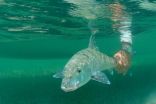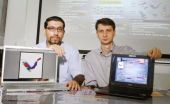Stability is first step toward treating ALS
A team of Brandeis scientists makes breakthrough with mutant gene that causes familial form of Lou Gehrig's disease
2010-11-23
(Press-News.org) Amyotrophic lateral sclerosis (ALS) is a fatal neurodegenerative disease that eventually destroys most motor neurons, causing muscle weakness and atrophy throughout the body. There is no cure and the current treatment has only a moderate effect on the march of the disease, which typically kills within three to five years. This week in PNAS, a team of Brandeis scientists reports an innovative approach to treating the most common form of familial ALS, commonly known as Lou Gehrig's disease.
In the study, researchers studied mutations in the gene that makes a particular protein, known as SOD1, responsible for causing much of the familial form of ALS, said Brandeis University chemist and study author Jeff Agar. Genetic mutations make the SOD1 protein unstable, causing it to fall apart into two identical pieces called monomers that are sticky and prone to clumping up inside the axon, the long projection of the motor neuron that conducts electrical impulses. Motor neurons are a meter long; when the axon inside the neuron gets clogged, it eventually dies.
"Picture a tennis ball stuck to a small piece of double sided tape. Now picture another. Turn the balls until both pieces of tape come into contact and that's what scientists call a dimer, and it's stable," explained Agar. "It won't stick to anything else. That's what normal SOD1 looks like, and there are billions of SOD1 dimers in every motor neuron.
Now pull the tennis balls apart, turn one 180 degrees, stick them back together and there's a sticky end. That's what ALS-associated SOD1 mutants do. You could stick millions of these balls together if you had them, and a neuron has billions of them. "What we're trying to do is prevent this from happening," said Agar.
Agar, along with post-doctoral fellow Jared Auclair, and biochemists Greg Petsko and Dagmar Ringe, developed an ingenious "chemical rope" to tie the two monomers together, creating a stable dimer. This strategy potentially solves the instability problem, especially since the protein proved able to withstand 40 degrees of heating above body temperature before falling apart again. SOD1 is one of the body's hardest working antioxidants, and its job is to turn a dangerous free radical called superoxide into water. Some ALS mutations stop SOD1 from doing its job, a process called inactivation, and the chemical ropes were even able to reactivate these SOD1 mutants and get them working again.
Next, the scientists had to create a version of their proof-of-concept "chemical rope" that was potentially amenable to development into a therapeutic, because the first one was toxic. Here they adopted a less toxic type of chemistry known as a thiol-disulfide exchange.
"This is only the beginning," said Agar. "It's one thing to do what we've done using purified proteins, but it is orders of magnitude more difficult to accomplish the same thing inside a complex organism. We have a lot more work to do before this could benefit ALS patients."
While the familial form of ALS, known as fALS, affects only about two percent of all ALS cases, there is growing evidence that changes in the same protein can cause some cases of sporadic (non inherited) ALS, and the researchers believe that perhaps 30 to 40 percent of cases where there is no genetic cause could potentially also benefit from the same treatment. The next step is to study SOD1 in cell cultures and in a mouse model to develop a pre-clinical candidate drug using this strategy.
INFORMATION:
The study was funded by the National Institutes of Health.
END
ELSE PRESS RELEASES FROM THIS DATE:
2010-11-23
Nov. 22, 2010 -- More than 170 participants gathered this week for the eighth annual National Academies Keck Futures Initiative (NAKFI) conference in Irvine, Calif. This year's topic, imaging science, a field of study that uses physics, chemistry, mathematics, computer science, and cognitive sciences to understand the many factors that influence and enable image capture and analysis. At the conference, top researchers from different fields discussed imaging science and its far-reaching applications -- such as astronomy, environmental monitoring, education, and health ...
2010-11-23
Johns Hopkins Children's Center scientists have discovered that high blood levels of a protein commonly found in the central nervous system can predict brain injury and death in critically ill children on a form of life support called extra-corporeal membrane oxygenation or ECMO.
ECMO, used to temporarily oxygenate the blood of patients whose heart and lungs are too weak or damaged to do so on their own, is most often used as a last resort because it can increase the risk for brain bleeding, brain swelling, stroke and death in some patients.
A detailed report of the ...
2010-11-23
HIV infected patients whose treatment is delayed not only become sicker than those treated earlier, but also require tens of thousands of dollars more in care over the first several years of their treatment.
"We know that it's important clinically to get people into care early because they will stay healthier and do better over the long run," says Kelly Gebo, M.D., M.P.H., an associate professor of medicine in the Division of Infectious Diseases at the Johns Hopkins University School of Medicine and the study's senior author. "But now we know it's also more costly to ...
2010-11-23
You detect an object flying at your head. What do you do? You probably first move out of the way -- and then you try to determine what the object is. Your brain is able to quickly switch from detecting an object moving in your direction to determining what the object is through a phenomenon called adaptation.
A new study in the Nov. 21 advance online edition of the journal Nature Neuroscience details the biological basis of this ability for rapid adaptation: neurons located at the beginning of the brain's sensory information pathway that change their level of simultaneous ...
2010-11-23
MIAMI – November 22, 2010 – This October more than 60 guides and anglers in the Florida Keys poled across the flats from Biscayne Bay to the Marquesas, assisting in the annual bonefish census. This year's count, held in extremely difficult weather with lowered visibility, was down by 25-percent from an 8-year mean estimate of 316,805 bonefish to a new low of about 240,000 bonefish, according to Professor Jerry Ault, a fisheries scientist with the University of Miami's Rosenstiel School of Marine & Atmospheric Science.
"Since 2003 we have conducted an annual bonefish ...
2010-11-23
In the future, tiny air vehicles may be able to fly through cracks in concrete to search for earthquake victims, explore a contaminated building or conduct surveillance missions for the military. But today, designing the best flying mechanism for these miniature aerial machines is still a challenging task.
Creating micro-scale air vehicles that mimic the flapping of winged insects or birds has become popular, but they typically require a complex combination of pitching and plunging motions to oscillate the flapping wings. To avoid some of the design challenges involved ...
2010-11-23
From fad diets to exercise programs, Americans continue to fight the battle of the bulge. Now they'll have help from recent Tel Aviv University research that has developed a new method to look at how fat cells -- which produce the fat in our bodies -- respond to mechanical loads.
This might be the key to understanding how to control the amount of fat produced by fat cells, the holy grail of weight loss researchers, says Prof. Amit Gefen of Tel Aviv University's Department of Biomedical Engineering. His research is driven by the theory that fat cells, like bone or muscle ...
2010-11-23
Fresh insight into how biological clocks adjust to having less sunlight in the winter could help us better understand the impact of jet lag and shift work.
Scientists studying the daily activity cycle in plants – known as circadian rhythms – have discovered a finely tuned process that enables the plant's genes to respond to the times of dawn and dusk each day, as well as the length of daylight in between.
This system helps the plant to reset its internal clock every day in response to seasonal changes in daylight, which helps the plant control the timing of key activities ...
2010-11-23
Infants are more efficient at digesting and utilizing nutritional components of milk than adults due to a difference in the strains of bacteria that dominate their digestive tracts. Researchers from the University of California, Davis, and Utah State University report on genomic analysis of these strains in the November 2010 issue of the journal Applied and Environmental Microbiology identifying the genes that are most likely responsible for this difference.
"Human milk oligosaccharides (HMOs) are the third-largest solid component of milk. Their structural complexity ...
2010-11-23
Direct contact and droplets are the primary ways influenza spreads. Under certain conditions, however, aerosol transmission is possible. In a study published in the current issue of Clinical Infectious Diseases, available online (http://www.journals.uchicago.edu/doi/abs/10.1086/656743), the authors examined such an outbreak in their own hospital in Hong Kong.
On April 4, 2008, seven inpatients in the hospital's general medical ward developed fever and respiratory symptoms. Ultimately, nine inpatients exhibited influenza-like symptoms and tested positive for influenza ...
LAST 30 PRESS RELEASES:
[Press-News.org] Stability is first step toward treating ALS
A team of Brandeis scientists makes breakthrough with mutant gene that causes familial form of Lou Gehrig's disease


